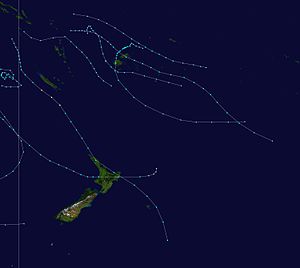1979–80 South Pacific cyclone season
| Category 2 tropical cyclone (Australian scale) | |
| Duration | December 9 – December 15 |
|---|---|
| Peak intensity | 100 km/h (65 mph) (10-min) 980 hPa (mbar) |
| Category 3 severe tropical cyclone (Australian scale) | |
| Category 1 tropical cyclone (SSHWS) | |
| Duration | January 1 – January 6 |
|---|---|
| Peak intensity | 120 km/h (75 mph) (10-min) 970 hPa (mbar) |
| Category 1 tropical cyclone (Australian scale) | |
| Tropical depression (SSHWS) | |
| Duration | February 2 – February 5 |
|---|---|
| Peak intensity | 65 km/h (40 mph) (10-min) 998 hPa (mbar) |
| Category 3 severe tropical cyclone (Australian scale) | |
| Category 1 tropical cyclone (SSHWS) | |
| Duration | March 9 – March 16 |
|---|---|
| Peak intensity | 120 km/h (75 mph) (10-min) 970 hPa (mbar) |
| Category 1 tropical cyclone (Australian scale) | |
| Tropical storm (SSHWS) | |
| Duration | March 22 – March 27 |
|---|---|
| Peak intensity | 85 km/h (50 mph) (10-min) |
| Category 1 tropical cyclone (Australian scale) | |
| Tropical storm (SSHWS) | |
| Duration | March 25 – March 28 |
|---|---|
| Peak intensity | 75 km/h (45 mph) (10-min) |
| Category 1 tropical cyclone (Australian scale) | |
| Tropical storm (SSHWS) | |
| Duration | April 1 – April 8 |
|---|---|
| Peak intensity | 65 km/h (40 mph) (10-min) 995 hPa (mbar) |
The 1979–80 South Pacific cyclone season saw mostly weak systems.
Ofa was classified on December 9. For several days it slowly deepened and on December 12 attained peak intensity while moving eastward. Three days later Ofa was no more.
Peni existed from January 1 to 6.
Rae lasted five days from February 2 to 7. It remained weak.
During the opening days of March 1980, a broad trough of low pressure, extended from Vanuatu to Queensland, Australia. A tropical depression subsequently developed, along this trough during March 9, near Rennell Island in the Solomon Islands. Over the next few days the system initially moved south-eastwards into the Australian region, as it gradually developed further before it turned south-westwards towards the South Pacific during March 10. The Australian Bureau of Meteorology, subsequently reported that the depression, had developed into a tropical cyclone and named it Sina during March 11. The system subsequently moved south-eastwards and back into the South Pacific basin, where it continued to intensify and move south-eastwards. During March 13, the system peaked as a Category 3 severe tropical cyclone with 10-minute sustained wind speeds estimated at 120 km/h (75 mph), as it passed about 200 km (125 mi) to the southwest of New Caledonia. After the system had peaked, it accelerated south-eastwards while gradually weakened and transitioning into a cold cored low. The system impacted northern New Zealand during March 15, before it was last noted during the following day.
Tia affected Fiji and Tonga.
Val affected Wallis and Futuna between March 25 - 29.
Wally lasted in the southern Pacific from April 1 to 7 and was a category one cyclone on the Australian tropical cyclone intensity scale with a peak pressure of 990 HpA/mbar. During its lifetime it made landfall on the second biggest island of Fiji – Viti Levu.
During January 9, the extratropical remnants of Tropical Cyclone Paul briefly moved into the region, before they moved back into the Australian region during the next day. The remnants subsequently moved back into the region during January 12, when they were last noted to the south of New Zealand's South Island. The precursor tropical depression to Severe Tropical Cyclone Simon, developed within the monsoon trough, to the northeast of New Caledonia during February 20. Over the next day the system moved eastwards and into the Australian region, where it ultimately developed into a severe tropical cyclone and impacted Queensland. During February 28, Simon's extratropical remnants moved back into the basin and impacted New Zealand, before they were last noted during March 3.
...
Wikipedia











